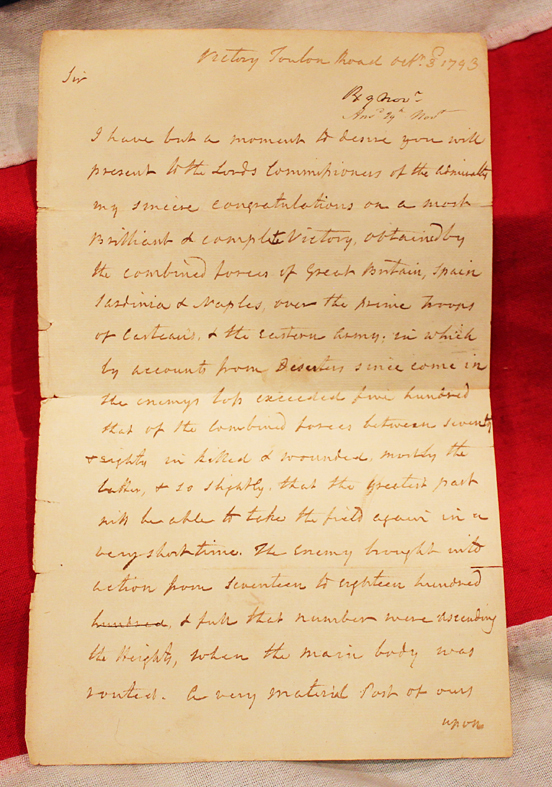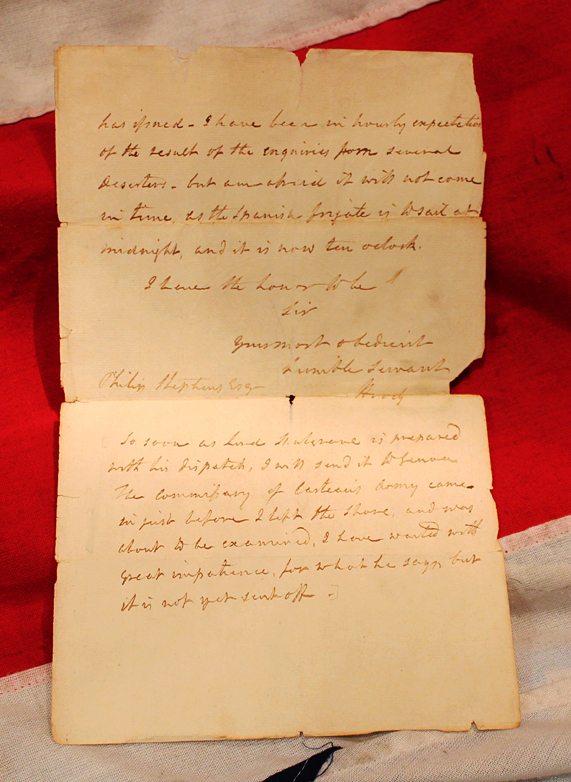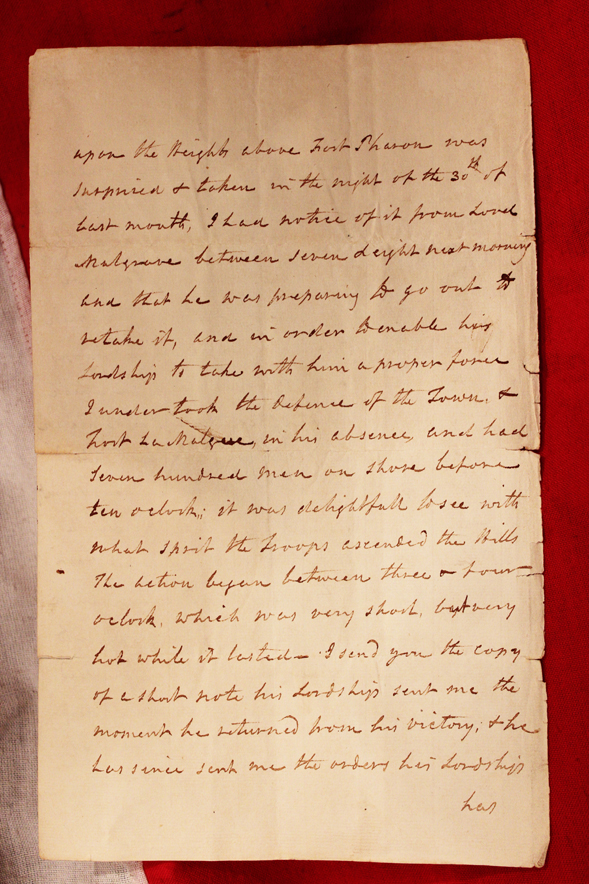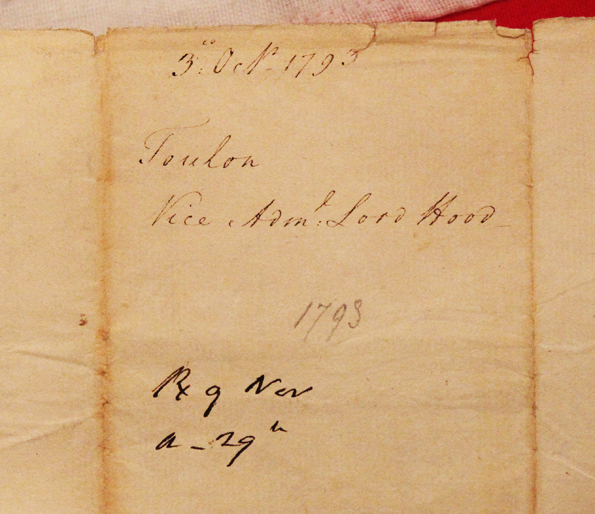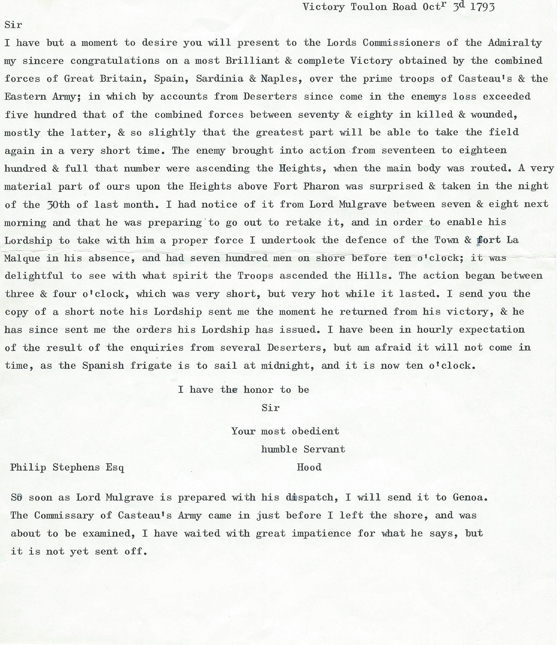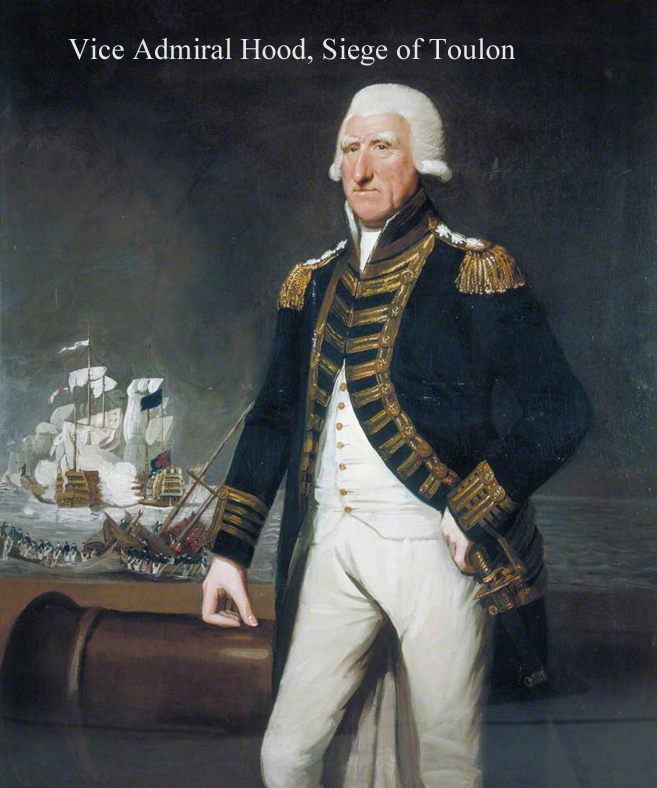Important & Historical Letter From Vice Admiral Hood Aboard HMS Victory with Nelson Regarding Their Combat At Toulon Against Napoleon In 1793. HMS Victory, Nelson's Flagship at The Battle of Trafalgar in 1805
A significant signed letter detailing the {temporary} victory of Hood and Nelson against Napoleon Bonaparte in his command as a Colonel Of Artillery For the Revolutionary French army, just before he turned the October loss into a French victory in December. and was promoted to General, then Ist Consul of France in 1799, then Emperor of France in 1804
One of the greatest and most famous Royal Naval Admirals. One of Britain's most famous Battle Ships was named in his honour HMS Hood, that was lost in combat in WW2, sunk by the Bismarck
Dated 3rd October 1793. by Admiral Hood, Horatio Nelson's commanding officer at the Siege of Toulon, where Napoleon was commanding the French Artillery before he became the leader of France .
This is a historically important letter for several reasons. It is signed and dated by one of England's greatest admirals, it was written and sent from the British flagship HMS. Victory, Horatio Nelson was there at the time under the command of Hood on his ship, and Napoleon Bonaparte was commanding the French artillery there against Hood and Nelson at the time of writing.
It would look simply amazing if bespoke framed with fine mounting and possibly complete with a fine print of HMS Victory or Admiral Hood. Regarding the Siege of Toulon just weeks before it fell. Two pages of foolscap, written on three sides, on correct 18th century Admiralty paper bearing Brittannia watermark, with date, location, name position and signature of Admiral Lord Hood. Personally hand written and signed aboard HMS Victory, by Admiral Lord Hood, addressed to Philip Stephens, First Secretary of the Admiralty and great friend of Capt. James Cook, to present to the Lord Commissioners of the Admiralty, his congratulations on a most Brilliant and complete Victory over the troops of General Carteaux Commander-in-chief of the Army before Toulon. It was at this engagement, part of the Siege of Toulon, that a young Corsican, a captain in command of artillery, Napoleon Buonaprte gained huge success, and the praises of the Generals, Committee of Public Safety, Augustin Robespierre and Antoine Christophe Saliceti, and thus his eventual promotion to Brigadier -General for his skill in his command of the batteries during the siege. The young artillery captain, Napoleon Bonaparte was appointed as Carteaux's new artillery commander. With the backing of the all-powerful Robespierre and Saliceti, the dynamic Bonaparte quickly devised a plan for the capture of the forts l'Eguillette and Balaguier. Bonaparte correctly surmised that the capture of these would allow accurate fire to be brought to bear on the Anglo-Neapolitan fleet and force it to abandon Toulon just after this letter was written. From this very siege Napoleon gained the influence and power that eventually changed the history of Europe forever. The significance of this event, it's highly important connecting points of the three great heroes, Hood, Napoleon and Bonaparte cannot be underestimated in it's position in world history. On 28 August, Admiral Sir Samuel Hood of the Royal Navy and Admiral Juan de Longara of the Spanish Navy, committed a force of 13,000 British, Spanish, Neapolitan and Piedmontese troops to the French royalists' cause. This was a serious blow to the arms of the republic, as it was a key naval arsenal of the country, with 26 ships of the line based there at the time (about one third of the total available to the French Navy). If France were to lose this port, there was no hope for her naval ambitions. Which would mean by proxy that any ambition to challenge the Allies, and specifically the British, for control of the seas would be out of the question. Not only that, but its loss could set a dangerous precedent for other areas that menaced the republic with revolt. The survival of the Republic was at stake. On 1 October, Baron d'Imbert proclaimed the young Louis XVII to be king of France, and hoisted the French royalist flag of the fleur de lys, delivering the town of Toulon to the British navy. It was not until 1793 that Napoleon was first able to demonstrate his ability to grasp the significant moment, to devise the successful strategy, to lead from the front and by example. In this year the year in which Louis XVI had been guillotined, at the beginning of what was to become The Terror Napoleon, now a twenty-four-year-old artillery captain, was given the opportunity to take control of artillery for the siege of Toulon.
At this time, there were still significant pockets of royalist insurrection against the revolution throughout the provinces, especially in the western Vendee region and in the South East. When royalist Marseille was retaken in August by the Jacobins, with appalling reprisals, the counter-revolutionaries holding Toulon called on the British Royal Navy to help them, along with their Spanish and other allies. Britain had been at war with France since the formation of the First Coalition of European allies against revolutionary France, formed earlier that year after the execution of Louis XVI.
The English fleet anchored in the harbour at Toulon was commanded by Rear Admiral Hood. Captain Horatio Nelson was with Hood's fleet, in command of the 64-gun third-rater Agamemnon. Britain's renewed conflict with France in 1793 meant officers of Nelson?s experience were required. He was given command of HMS Agamemnon on 30 January 1793. Nelson sailed to the Mediterranean in May 1793, joining Lord Hood's fleet blockading the French fleet in Toulon. Josiah, his stepson, accompanied him. His wife, Fanny, was left to worry about the dangers they faced. Nelson's letters to her at this time showed signs that their relationship was under strain. Hood ordered Nelson to Naples to seek King Ferdinand IV's help in defending Toulon against French republicans. Nelson made this request through Sir William Hamilton (1730-1803), the British envoy, at the Palazzo Sessa. It was here in September 1793 that he met Emma Hamilton, the envoy's second wife, aged 28, who was reputed to be one of the most beautiful women of her time. Nelson informed Fanny that Lady Hamilton has been wonderfully kind and good to Josiah She is a young woman of amiable manners?who does honour to the station to which she is raised? (Nicolas, Volume 1, page 326). Having negotiated a promise of 6,000 troops for the siege of Toulon, Nelson returned there to be ordered to join Commodore Robert Linzee's squadron in Tunis. Linzee was in negotiation with the Bey to hand over a French squadron under his protection. En route, on 22 October 1793, Nelson fell in with some French frigates and engaged the Melpomone, but his ship was beaten off by superior forces. The diplomatic mission to Tunis proved unsuccessful. Nelson considered Linzee's approach too cautious, I should have taken every Frenchman here without negotiating; even had the negotiations taken place, I would have had the French men-of-war and believe that the people of England will never blame an officer for taking a French line of Battle ships
The Hood family, from 1st Viscount Hood down was a lineage that has produced some of the greatest fighting men to serve in the Royal Navy. Battle Cruiser H.M.S. Hood (1920-1941) Named in honour of the 1st Viscount Admiral Hood was the third and most famous ship to bear the name, the legendary battle cruiser that during her 21 year long career, she, more than any other ship, would stand as the ultimate symbol of the Empire's might. Of all the vessels to bear the name, she was the most important, most memorable and most loved. She was lost with all hands bar three in her catastrophic engagement with the German Heavy Cruiser Prinz Eugen and the German Battleship Bismarck at the Battle of Denmark Strait 24th May 1941. Original letter shown with a newly typed version for reading assistance.
Code: 22821
3495.00 GBP

